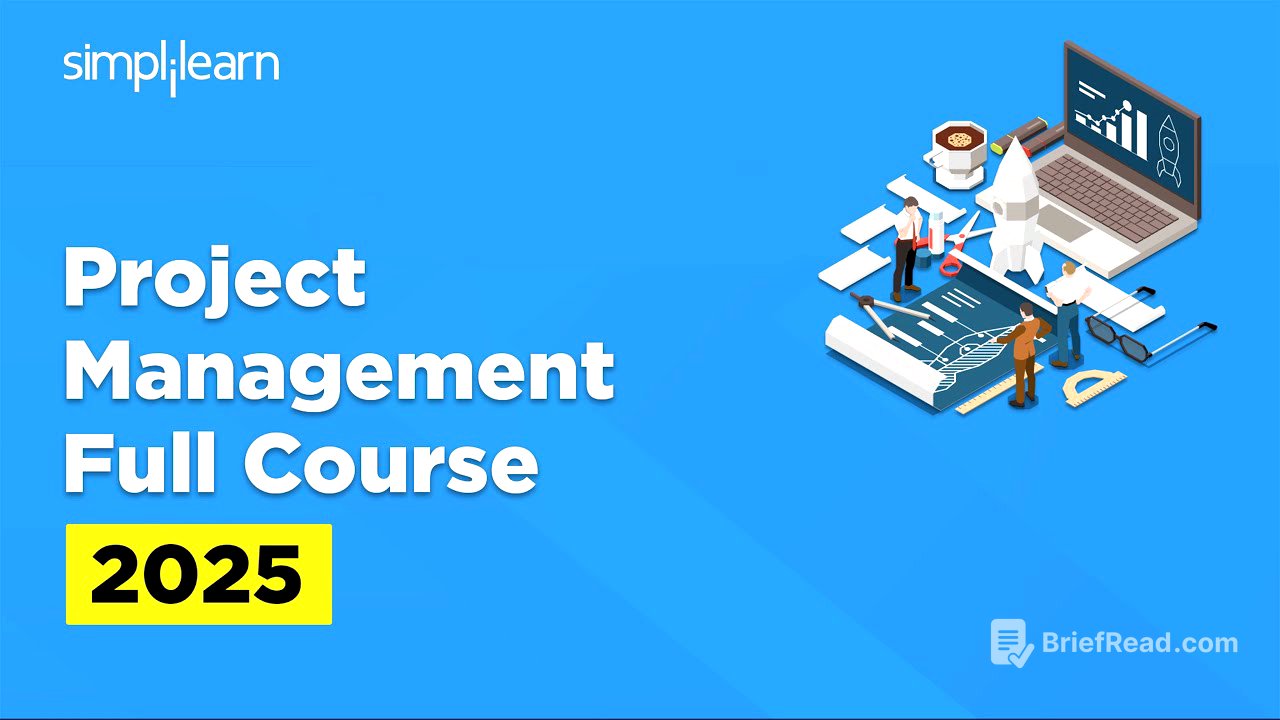TLDR;
This comprehensive project management course covers essential skills, methodologies, and tools for project managers. It includes an overview of project management principles, agile methodologies, PMP certification, and practical techniques for planning, scheduling, budgeting, and risk management. The course also provides guidance on answering product management interview questions and using project management tools.
- Project management principles and methodologies
- Agile and Scrum frameworks
- PMP certification and exam guide
- Practical techniques and tools
- Interview preparation
Introduction to Project management full course [0:00]
This course equips individuals with essential project management skills, covering planning, scheduling, budgeting, and risk management. It explores methodologies like Agile and Waterfall, demonstrating their application in real-world projects. The course aims to provide the knowledge and tools necessary to confidently manage projects of any size. Simplilearn's PMP certification training is highlighted as a pathway to becoming a certified project management professional, offering master classes, PDUs, simulation assessments, and practice sessions.
What is project management [21:28]
Project management involves applying knowledge, skills, tools, and techniques to project activities to meet project requirements. Every project has an objective, and project management aims to deliver final deliverables within a finite time and budget. This requires a clear understanding of deliverables, resources (human, technical, financial), and constraints. Key constraints include scope, time, quality, cost, risk, and resources, each playing a vital role in project management.
What is agile project management [29:37]
Agile project management is a flexible approach where projects are divided into stages or sprints. Unlike traditional methods, Agile delivers sections of a project or mini-projects incrementally. The Agile development cycle includes product backlog, sprint backlog, planning, designing, execution, testing, and deployment stages. This approach allows for continuous addition of new features and early validation, reducing the chances of failure.
All about PMP Certification [30:34]
The PMP (Project Management Professional) certification is a globally recognized credential offered by the Project Management Institute (PMI). It enhances a project manager's credibility, potentially leading to better job opportunities and higher salaries. The certification process involves gaining project management experience and passing the PMP exam. PMP certification helps individuals become better project managers, makes resumes more valuable, provides more job opportunities, leads to salary hikes, validates dedication to the job, is globally acknowledged, and improves project performance.
PMP Exam Guide [47:06]
The PMP exam comprises 200 questions, with 175 used for evaluation, and requires thorough knowledge of five process groups and 10 knowledge areas. The exam lasts four hours and includes formula-based, situation-based, and knowledge-based questions. The PMBOK (Project Management Body of Knowledge) guide is essential for exam preparation, covering processes and terminologies. The exam costs $405 for PMI members and $555 for non-members, with the certification valid for three years, renewable with 60 PDUs (Professional Development Units).
Project Management Roadmap for beginners [59:50]
Project management involves planning, organizing, and orienting a project to meet specific goals within a set timeframe and budget. Key skills include communication, organization, problem-solving, leadership, time management, and adaptability. Core concepts are scope, resources, schedule, budget, risk management, and quality. Methodologies include Waterfall, Agile, and Scrum. Tools for project planning are Gantt charts, critical path method, project evaluation and review technique, work breakdown structure, and project documentation.
What is Agile Methodology [1:05:41]
Agile methodology aims to meet consumer requirements by deploying changes in a rapidly developing environment. The Agile Manifesto principles bring an innovative set of rules and protocols to help developers overcome challenges faced in traditional practices like the Waterfall model, making Agile flexible and efficient. The Agile Manifesto emphasizes individuals and interactions, working software, customer collaboration, and responding to change.
Agile Principles [1:15:02]
The 12 principles of Agile software development advocate for customer satisfaction through early and continuous software delivery. They prioritize adapting to changing requirements, frequent delivery of working software, collaboration between business people and developers, motivated individuals, face-to-face conversations, working software as the primary measure of progress, sustainable development, technical excellence, simplicity, self-organizing teams, and regular reflection on effectiveness.
Scrum Meeting Explained [1:17:32]
Scrum meetings ensure alignment, transparency, and collaboration among team members. They allow teams to adapt plans based on daily progress and emerging challenges, improving communication, collaboration, and productivity. Standard questions include what was done yesterday, what will be done today, and any obstacles encountered. The Scrum Master facilitates the meeting, ensuring it stays focused and time-boxed, typically around 15 minutes.
Kotters 8 step model explained [1:28:33]
Kotter's 8-step model for change management involves creating a platform for change, implementing changes successfully, and sustaining change. The first three steps include creating a sense of urgency, forming a guiding coalition, and creating a strategic vision. Implementing change involves communication, removing barriers, and generating short-term wins. Sustaining change includes building on the change and anchoring it in corporate culture.
How to be Project Manager [1:38:39]
To become a project manager, one must understand the role, acquire education and certifications, gain relevant experience, develop key skills, expand knowledge, build a network, demonstrate leadership, develop a portfolio, pursue professional growth, seek employment opportunities, and ace the interview. Entry-level project managers in the USA can earn $60,000 to $70,000 annually, while senior project managers can exceed $120,000. Top companies hiring project managers include Amazon, Google, Microsoft, Apple, and Facebook.
Project Management [6:27:15]
Microsoft Excel is a tool for project management, aiding in planning, data analysis, and tracking progress. It offers analytical tools and project management templates. Creating a Gantt chart in Excel involves making a project table, creating a bar chart, adding duration, adding descriptions, and formatting the chart. Excel templates for project management include project review, budget, sprint project tracker, project tracker, project schedule, project status report, milestone tracker, and project planner templates.
Prioritization Techniques [6:29:26]
Prioritization techniques help determine the order of importance for tasks, activities, or elements within a project. Techniques include the MoSCoW method (Must have, Should have, Could have, Won't have), Kano model, RICE scoring model (Reach, Impact, Confidence, Effort), Eisenhower Matrix (Urgent/Important), Value vs. Complexity Matrix, Weighted Shortest Job First (WSJF), and Walking Skeleton Method. Choosing the right technique depends on simplicity, data-driven approach, balance between technology constraints and business value, and the best use case.
Product Lifecycle Management [6:49:14]
Product Lifecycle Management (PLM) guides companies through a product's entire journey from concept to retirement. The phases include concept and design, development, production and launch, service and support, and retirement. Tracking KPIs such as on-time delivery, user engagement, conversion rates, and customer satisfaction is crucial. The future of PLM involves AI, eco-friendly practices, and global connectivity.
What is product market fit [7:08:50]
Product Market Fit is when a company's product resonates deeply with its target customers, who regularly use and recommend it. Achieving this requires collaboration across all departments. Key indicators include customer feedback, market differentiation, product understanding, and retention rates. To achieve product market fit, one must determine the target customer, identify underserved needs, define the value proposition, specify the minimum viable product, develop the MVP, and test the MVP with customers.
PMP 6th edition training [8:26:13]
PMP (Project Management Professional) certification is an internationally recognized credential from PMI (Project Management Institute). It requires sufficient experience, education, skills, and competency. Eligibility criteria include a secondary degree with 7,500 hours of experience or a four-year degree with 4,500 hours of experience, plus 35 hours of project management education. The PMBOK (Project Management Body of Knowledge) guide is the basic reference for the PMP exam.
Project Management in Software Engineering [8:39:50]
Project management in software engineering involves initiation, planning, execution, monitoring and controlling, and closure. Project planning includes scope, scheduling, resource planning, budgeting, and risk management planning. Execution involves team formation, task assignment, and quality assurance. Monitoring and controlling includes progress tracking, performance reporting, change management, and quality control. Closure includes final deliverables, project documentation, post-project review, and stakeholder satisfaction.
How to answer Product Management Interview Questions [8:41:19]
To answer product management case study questions, listen carefully, take notes, ask clarifying questions, pause and think, structure your answer (problem, approach, solution, metrics), explain your thought process, pivot and check in with the interviewer, and summarize your answer. Types of questions include product design, go-to-market strategy, feature prioritization, metrics and data analysis, and behavioral questions.
Top 10 PM Tools [9:14:47]
Top tools for product management include Pendo (user tracking and analysis), Product Board (product strategy and roadmapping), Microsoft Visio (flowcharting), Microsoft PowerPoint (presentation), Balsamiq (prototyping and wireframing), Rally (product development), Jira (project management), Trello (collaboration), Adobe Target (user experience and testing), and SurveyMonkey (customer feedback and survey). Bonus tools include Slack and Canva.
Project Manager Interview Questions [10:01:06]
Typical Scrum interview questions include defining Scrum, roles in Scrum (Product Owner, Scrum Master, Scrum Team), responsibilities of the Scrum Team, differences between Agile and Scrum, Scrum artifacts (Product Backlog, Sprint Backlog, Product Increment), differences between Product Backlog and Sprint Backlog, the role of the Scrum Master, what happens in Daily Standup sessions, ScrumBan, Sprint Zero and Spike, Scrum of Scrums, User Story Mapping, Sprint Retrospective, empirical process control, drawbacks of using Scrum, skills of a Scrum Master, dealing with discord, user stories, epics, tasks, and velocity.









